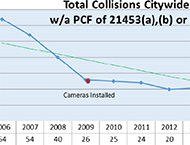1/17/2017
Napa, California Considers Doing Business With RedflexThe city council in Napa, California will vote on whether to continue doing business with the embattled red light camera vendor.

Officials in Napa, California will decide later today whether to continue doing business with Redflex Traffic Systems, the Australian red light camera vendor embroiled in an ongoing international corruption scandal. Following the city council's lead, Police Chief Steve Potter will argue in favor of the program's continuation, facing off against Mayor Jill Techel, a consistent voice against the program.
Chief Potter's primary argument, supplied in a memo sent to the council in advance of the meeting, is that the red light camera program has created a 59 percent drop in red light related collisions. The chief also mentions that profit from the program is deposited in a police department traffic safety fund, which he has used to buy fourteen handheld radar and laser speed guns for his patrol officers. The editor of the HighwayRobbery.net website fired back with a memo to the city council showing how the city's own data undermines the chief's claims.
"That remarkable figure has been placed in those prominent places to 'sell' you, but I submit that for the following reasons, that figure is entitled to zero weight in your decision making," the memo explained. "[The city] staff's own graph shows that the claimed decrease occurred in 2006 to 2008, which was before the cameras were installed."
One of the primary factors in the accident drop, the second memo explained, was that Napa stopped reporting and responding to minor traffic collisions. This view is bolstered by the findings of the Napa County Grand Jury, which released a report in 2011 slamming the automated ticketing program (view report).
"The data more clearly shows that the incidents of injury accidents have been on a steady decline since 2007 with the highest level of decline occurring between 2007 and 2008 prior to the installation of the automated red light enforcement system," the grand jury concluded.
The grand jury also criticized city officials for making millions from harmless infractions, particularly at Highway 29 and Highway 121. This is the city's most profitable intersection, which doled out 78 percent of its tickets to motorists turning right on red, even though not a single accident had been reported involving a turning car and a pedestrian or other automobile.
In 2015, the city was caught with illegally short yellow times at Jefferson Street and First Street, and the California Department of Transportation ordered longer yellows at Soscol Avenue and Imola Avenue. The increased yellow timing resulted in an immediate drop in the number of violations, which local activists argue is a superior alternative to continuing to use the cameras.
More cities in California have dropped red light cameras than have voted to continue their use. The list of canceled camera programs includes: Belmont, Bell Gardens, Berkeley, Burlingame, Cerritos, Compton, Corona, Costa Mesa, Cupertino, El Cajon, Davis, El Monte, Escondido, Emeryville, Fairfield, Fresno, Fullerton, Gardena, Glendale, Grand Terrace, Hayward, Highland, Indian Wells, Irvine, Laguna Woods, Lancaster, Loma Linda, Los Angeles, Long Beach, Marysville, Maywood, Montclair, Moreno Valley, Oakland, Paramount, Pasadena, Poway, Rancho Cucamonga, Redlands, Redwood City, Rocklin, Roseville, Rowland Heights, San Bernardino, San Carlos, San Diego, San Jose (photo radar), San Juan Capistrano, Santa Fe Springs, Santa Maria, Santa Rosa, South Gate, Stockton, Union City, Vista Upland, Walnut, Whittier, Yuba City and Yucaipa. The city councils of Laguna Niguel and Orange passed ordinances banning cameras in 2011. Residents of Anaheim, Murrieta and Newport Beach voted to ban red light cameras at the ballot box.
Update: The city council voted 4 to 1 not to renew the red light camera program. The contract with Redflex will expire in February.


